
Let’s head north out of the Doughty Building, last post’s feature, and pay a visit to its neighbor at 301-303 James Brown Blvd, the Lowrey Wagon Works aka the Confederate Boot Factory. I passed this vacant and unmarked structure at the corner of 9th and Ellis Streets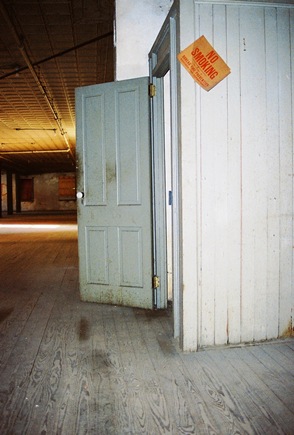 countless times and never gave it a second thought. That was my mistake as the history of this place is fairly fascinating. However, the building is sort of designed to look unassuming. Three stories tall and made of brick, for some reason it was covered in stucco and then scored to look like it was constructed of cinderblock. It’s unassuming alright. And very old. Luckily, Rob Pavey of the Augusta Chronicle did an excellent story on the place in late 2007; most of my information comes from his discussion with Erick Montgomery of Historic Augusta for that piece.
countless times and never gave it a second thought. That was my mistake as the history of this place is fairly fascinating. However, the building is sort of designed to look unassuming. Three stories tall and made of brick, for some reason it was covered in stucco and then scored to look like it was constructed of cinderblock. It’s unassuming alright. And very old. Luckily, Rob Pavey of the Augusta Chronicle did an excellent story on the place in late 2007; most of my information comes from his discussion with Erick Montgomery of Historic Augusta for that piece.
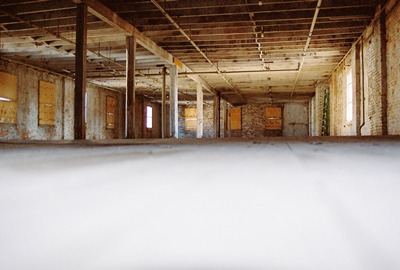
Built in the fall of 1860, initially the building housed the Lowrey Wagon Works only briefly. By April of 1861, with the Civil War beginning, it became a boot factory for the Confederacy. In 1865, after the war, the building was seized by the federal government and given to some local churches to use as a school for freed African-American children. A newspaper noted that the school was "attended by nearly 500 boys and girls" who could "read tolerably well."

The school soon moved to a larger building and, in 1866, J.H. Lowrey returned to his wagon works to make a real go of it for the next 40 years. Lowrey’s red and green wagons were known for their quality and the company claimed they were found “from Viriginia to Mississippi.” “Go on what plantation you will. There, almost as much a part and parcel of the upturned earth of the furrows, there will be found a Lowrey Wagon," read a rather poetic ad in the Augusta Chronicle.
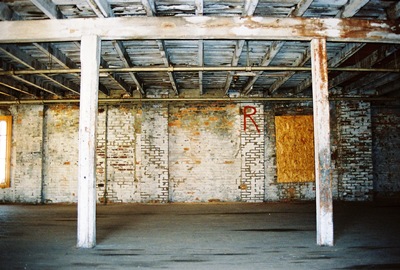
Lowrey did so well that he expanded his manufacturing throughout downtown Augusta and, when he died in 1909, his son, Henry K. Lowrey, took over the company. But, when Henry died in 1925, the business was shuttered. Henry’s grandson and noted Augusta architect, then-90-year-old Lowrey Stulb, told the Chronicle that he visited the wagon works when he was young and saw the wagons being built. "They had a two-horse, a four-horse, and I suppose they made some surreys too," Mr. Stulb said. "The wagons were green and red and had 'Lowrey' painted on the side."
Right after the wagon works shut down, the building was bought by department store magnate J.B. White and used as office space. It also housed a bike shop and, clearly, in one of its last incarnations, a restaurant was on the lower level. There is no indication of its name, although the inscription “Good things to eat” remains on an outside wall. What I don’t have a picture of are the two camera obscurae which have been created by two little holes in the plywood covering the windows of the front doors. While mostly projecting the parking garage across the street, they are still eerily beautiful and, like the now-empty Lowrey Wagon Works building itself, known about by only a very few.
clearly, in one of its last incarnations, a restaurant was on the lower level. There is no indication of its name, although the inscription “Good things to eat” remains on an outside wall. What I don’t have a picture of are the two camera obscurae which have been created by two little holes in the plywood covering the windows of the front doors. While mostly projecting the parking garage across the street, they are still eerily beautiful and, like the now-empty Lowrey Wagon Works building itself, known about by only a very few.
Thanks to Historic Augusta and the 2012 Augusta Photography Festival for providing access.
Next we’ll visit the fireproof building that was gutted by fire less than two years after its initial construction. Yup, that would be the Marion Building.
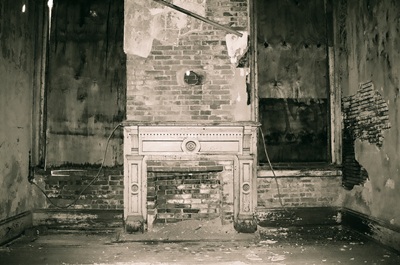
Let’s start our trip back to Augusta, Georgia at the intersection of two of my favorite streets, Ellis and James Brown Blvd (aka 9th St.). In ’03 and ’04 I used to wander around this area a lot and I took many photographs. Later, I did entire posts on Ellis St. and JB Blvd. Ellis St. has got to be cool if Dinosaur Jr. shot the first part of their video for Over It there. At the time, I didn’t know much about the history of the buildings I was visiting. For many of them, this is still the case. But, with the help of Historic Augusta, this year’s Augusta Photography Festival got access to one that I passed many times, so now I know at least a little something about it. One of the things I know is that it’s got some great fireplaces. The two featured at the top and bottom of this post were up on the second floor. Those are the original mantels, too.

This building, at 307 James Brown Blvd, just south of Ellis, we'll call the Doughty Building since the three-and-a-half story Second Empire style structure was built by Dr. William H. Doughty, Sr. as an investment property between 1884 and 1890. Yup, it’s old. And it's on the National Register of Historic Places. Dr. Doughty’s son, William Jr., was Dean of the Medical College of Georgia from 1910-1923. His tenure ended suddenly when he died from an infection following a tooth extraction. I’m not sure if there’s irony to be found there or not. But I digress. The building was originally intended to be a commercial townhouse but by the late 1800’s it was a Chinese laundry operated by Sang Sing and Sang Lee. Clothes were washed into the 1900’s and then, in 1917, the building was bought by Mrs. Ellen J. Doremus, the daughter of former Augusta Mayor Charles Estes. Mrs. Doremus paid $8000 for the place and the lower level, at least, remained mostly commercial space. Now part of the first floor is home to a furniture refinishing shop but most of the rest of the building is vacant and just waiting for someone to come along and give it a helping hand. There's what appears to be about 120 years worth of wallpaper at the foot of these entryway stairs.
I’m not sure if there’s irony to be found there or not. But I digress. The building was originally intended to be a commercial townhouse but by the late 1800’s it was a Chinese laundry operated by Sang Sing and Sang Lee. Clothes were washed into the 1900’s and then, in 1917, the building was bought by Mrs. Ellen J. Doremus, the daughter of former Augusta Mayor Charles Estes. Mrs. Doremus paid $8000 for the place and the lower level, at least, remained mostly commercial space. Now part of the first floor is home to a furniture refinishing shop but most of the rest of the building is vacant and just waiting for someone to come along and give it a helping hand. There's what appears to be about 120 years worth of wallpaper at the foot of these entryway stairs.
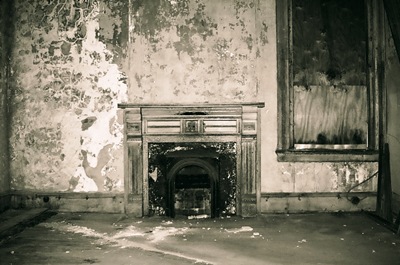
If perhaps you'd like to purchase this building (now at $59,900), Historic Augusta's listing is a good place to start. There is a preservation easement on the property, so at least it's got some protection. Besides Historic Augusta's webpage, I got a lot of information for this post from material they originally put together for a loft tour and which was used again during our visit. I learned about Dr. William Doughty, Jr.’s tragic fate from the Medical College of Georgia’s old website.
The next post will be on the Doughty Building’s neighbor at 301 James Brown Blvd (you can see a little of it at the right in the color photo above), the Lowrey Wagon Works aka the Confederate Boot Factory. So, yes, this one will be pre-Civil War.
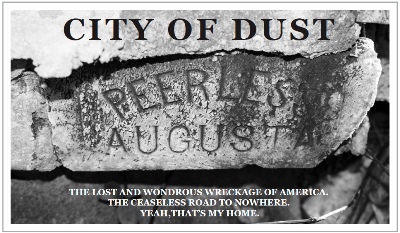
I’m just back from the 2012 Augusta Photography Festival in Augusta, Georgia. This visit back to the place where I first conceived of City of Dust, and the related exhibit which I was at least partially there to promote, are the best things that have ever happened as a result of my photography and attendant attempts at historical documentation. And it was all because of this website. So, let’s hear it for the internet. It does occasionally produce results that would not be possible otherwise. I still recommend being wary of it though. You never know what you might find or how much time it will cost you.
Anyway, the City of Dust exhibit has had its run at the Augusta Public Library extended until at least November 14th. Three sets of three Stonehenge-sized panels occupy space beside the stairway on all three floors of the Main Branch at 823 Telfair Street. Walk right in the front door and you can’t miss ‘em. This beautiful new library is right off James Brown Boulevard, which I used to explore when it was considerably more desolate.
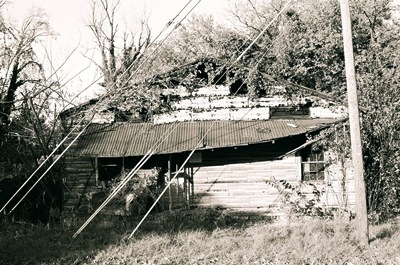
Once the exhibit closes at the library, it will move over to the Aiken County Historical Museum in South Carolina. This is very exciting. It certainly beats having the panels cut-up for fire wood since they’re too big to store in even a good-sized garage. The exhibit might be available for viewing at the museum as early as December 3rd. The Aiken Historical Museum occupies a 1930’s-era mansion named “Banksia” and it’s at 433 Newberry St. SW in Aiken. Like the library, admission is free, but why not become a member? Tell them City of Dust sent you!
In the spirit of the exhibit, the festival offered two excellent photo safaris to some historic buildings in downtown Augusta. One, the Miller Theater, City of Dust has visited before. But this time I got better photos. The other sites were the Marion and Doughty Buildings and the Lowrey Wagon Works/Confederate Boot Factory, none of which I had anything close to access to previously. As after my last trip in 2010, when I stopped by James Brown’s old neighborhood and dug up some information on the Palace Theater,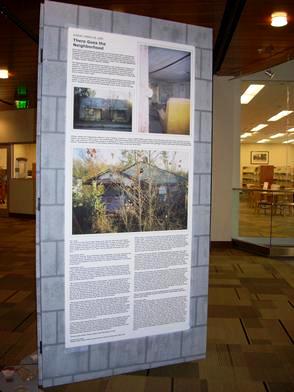 the next few posts will document the places I photographed while back in Georgia. In addition to the safari buildings, I found a few new out-of-the-way spots and checked-out what remained of some old favorites, like that house above in the Harrisburg neighborhood. Yes, it looks worse now. I also learned a few things. See that brick at the top? I really knew nothing about the factory from which it came, even though I did a whole post on the place years ago. Now, a lecture attendee has told me it was probably the Hankinson and Haugh factory. And the old freezer facility on Walker St. that was torn down? It was owned by Swift and burned in a fire started by homeless people in which one person died. Anyway, like in the old days I hope to do this series of posts quickly, in contrast to my current once-per-month-if-I’m-lucky pace. So, stay tuned and we’ll get started shortly.
the next few posts will document the places I photographed while back in Georgia. In addition to the safari buildings, I found a few new out-of-the-way spots and checked-out what remained of some old favorites, like that house above in the Harrisburg neighborhood. Yes, it looks worse now. I also learned a few things. See that brick at the top? I really knew nothing about the factory from which it came, even though I did a whole post on the place years ago. Now, a lecture attendee has told me it was probably the Hankinson and Haugh factory. And the old freezer facility on Walker St. that was torn down? It was owned by Swift and burned in a fire started by homeless people in which one person died. Anyway, like in the old days I hope to do this series of posts quickly, in contrast to my current once-per-month-if-I’m-lucky pace. So, stay tuned and we’ll get started shortly.
Thanks to Tricia and Peter Hughes for all their hard work and dedication to construction and promotion. Thanks also to the Augusta Public Library, the Friends of the Library, the Augusta Photography Festival and Rebecca Rogers, and Verge Magazine and Mary Bordeaux for publishing many fine articles in advance of the festival. Also, thanks to the Aiken County Historical Museum for offering to host the exhibit next month. Finally, thanks to Lowe’s for donating the material used to make the panels themselves. Many thanks everyone!

 countless times and never gave it a second thought. That was my mistake as the history of this place is fairly fascinating. However, the building is sort of designed to look unassuming. Three stories tall and made of brick, for some reason it was covered in stucco and then scored to look like it was constructed of cinderblock. It’s unassuming alright. And very old. Luckily, Rob Pavey of the Augusta Chronicle did an excellent story on the place in late 2007; most of my information comes from his discussion with Erick Montgomery of Historic Augusta for that piece.
countless times and never gave it a second thought. That was my mistake as the history of this place is fairly fascinating. However, the building is sort of designed to look unassuming. Three stories tall and made of brick, for some reason it was covered in stucco and then scored to look like it was constructed of cinderblock. It’s unassuming alright. And very old. Luckily, Rob Pavey of the Augusta Chronicle did an excellent story on the place in late 2007; most of my information comes from his discussion with Erick Montgomery of Historic Augusta for that piece.


 clearly, in one of its last incarnations, a restaurant was on the lower level. There is no indication of its name, although the inscription “Good things to eat” remains on an outside wall. What I don’t have a picture of are the two camera obscurae which have been created by two little holes in the plywood covering the windows of the front doors. While mostly projecting the parking garage across the street, they are still eerily beautiful and, like the now-empty Lowrey Wagon Works building itself, known about by only a very few.
clearly, in one of its last incarnations, a restaurant was on the lower level. There is no indication of its name, although the inscription “Good things to eat” remains on an outside wall. What I don’t have a picture of are the two camera obscurae which have been created by two little holes in the plywood covering the windows of the front doors. While mostly projecting the parking garage across the street, they are still eerily beautiful and, like the now-empty Lowrey Wagon Works building itself, known about by only a very few.

 I’m not sure if there’s irony to be found there or not. But I digress. The building was originally intended to be a commercial townhouse but by the late 1800’s it was a Chinese laundry operated by Sang Sing and Sang Lee. Clothes were washed into the 1900’s and then, in 1917, the building was bought by Mrs. Ellen J. Doremus, the daughter of former Augusta Mayor Charles Estes. Mrs. Doremus paid $8000 for the place and the lower level, at least, remained mostly commercial space. Now part of the first floor is home to a furniture refinishing shop but most of the rest of the building is vacant and just waiting for someone to come along and give it a helping hand. There's what appears to be about 120 years worth of
I’m not sure if there’s irony to be found there or not. But I digress. The building was originally intended to be a commercial townhouse but by the late 1800’s it was a Chinese laundry operated by Sang Sing and Sang Lee. Clothes were washed into the 1900’s and then, in 1917, the building was bought by Mrs. Ellen J. Doremus, the daughter of former Augusta Mayor Charles Estes. Mrs. Doremus paid $8000 for the place and the lower level, at least, remained mostly commercial space. Now part of the first floor is home to a furniture refinishing shop but most of the rest of the building is vacant and just waiting for someone to come along and give it a helping hand. There's what appears to be about 120 years worth of 


 the next few posts will document the places I photographed while back in Georgia. In addition to the safari buildings, I found a few new out-of-the-way spots and checked-out what remained of some old favorites, like that house above in the
the next few posts will document the places I photographed while back in Georgia. In addition to the safari buildings, I found a few new out-of-the-way spots and checked-out what remained of some old favorites, like that house above in the